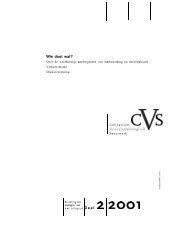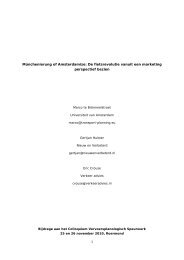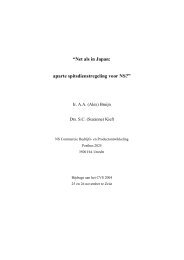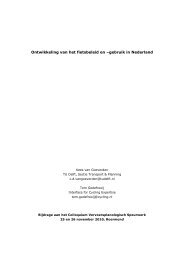- Page 1 and 2:
ColloquiumVervoersplanologischSpeur
- Page 3 and 4:
COLLOQUIUM VERVOERSPLANOLOGISCH SPE
- Page 5 and 6:
LIST OF PUBLISHED PROCEEDINGS OF TH
- Page 7 and 8:
13. F. le Clercq (red.)“Colloquiu
- Page 9:
De publikaties welke nog op voorraa
- Page 12 and 13:
Ook dit jaar heeft het bestuur weer
- Page 15 and 16:
INHOUDSOPGAVE NAAR SESSIEVoorwoordI
- Page 17 and 18:
27 Jansen, A., D. Drenth & B. van S
- Page 19 and 20:
Sessie BS: Beleidsvorming53 Zuylen,
- Page 21 and 22:
75 Immers, B., B. Egeter & M. Marte
- Page 23 and 24:
INHOUDSOPGAVE NAAR AUTEURVoorwoordI
- Page 25 and 26:
61 Ham, J.C. vanEen toekomst voor i
- Page 27 and 28:
76 Poppe, F. & R. GaljaardEen ‘du
- Page 29 and 30:
15 Weebers, J., H. Tromp & D. Buite
- Page 31 and 32:
TABLE OF CONTENTS BY SESSIONForewor
- Page 33 and 34:
27 Jansen, A., D. Drenth & B. van S
- Page 35 and 36:
Session B5: Policy development53 Zu
- Page 37 and 38:
78 Schoemakers, A.Sustainable safet
- Page 39 and 40:
81 Comrnandeur, P.R., M. Schreuders
- Page 41 and 42:
60 Kraan, M.M., S.J.C.M. Weijers &
- Page 43 and 44:
59 Veen-Groot, D. van & P. NijkampG
- Page 45:
Se&e Bl - B4:-ctllllr533
- Page 48 and 49:
lnhoudsopgave1. lnfrastructuur ....
- Page 50 and 51:
21. Infrastructuur1.1 De meerwaarde
- Page 52 and 53:
4. andere bijzondere punien zijn st
- Page 54 and 55:
6Vervoerstromen kunnen sterk in de
- Page 56 and 57:
8plan voor halfondergrondse spoorli
- Page 58 and 59:
104.1 Lndeling stedelijke gebiedenI
- Page 60 and 61:
12maar vergen ook een ingrijpende h
- Page 62 and 63:
145.2 Lijnvormige infrastructuurDe
- Page 64 and 65:
16- (‘hamps ElysCes (Par+, Frankr
- Page 66 and 67:
18plaats waar het werk lag en een b
- Page 68 and 69:
20referenties....................Bo
- Page 70 and 71:
Paper voor het Colloquium Vervoersp
- Page 72 and 73:
1. Beheersen of ontwerpen: een klas
- Page 74 and 75:
was het doel, maar van hoe dat erui
- Page 76 and 77:
Figuur 1 Relatie mssen de drie bouw
- Page 78 and 79:
10Tabel 1 moet beschouwd worden als
- Page 80 and 81:
1 2infrastructuur zelf. Maar missch
- Page 82 and 83:
14Er is een spanning te constateren
- Page 84 and 85:
Tabel 2 lnpassingseffectenbeschrljv
- Page 86 and 87:
INHOUD1. Inleiding2. De structuur v
- Page 88 and 89:
11. InleidingDe aanleg van de Hoges
- Page 90 and 91:
33. Een toen moest het interactief.
- Page 92 and 93:
5Alleen voor het tracedeel bij Bred
- Page 94 and 95:
voorafgaandeontwerp-trackbesluit.7B
- Page 96 and 97:
94.3. Wat er volgens de omwonenden
- Page 99:
125. Het vervolgDe werkbijeenkomste
- Page 102 and 103:
InhoudsopgaveSamenvatting1. Inleidi
- Page 104 and 105:
1. InleidingBij discussies over het
- Page 106 and 107:
Dit moet dan prioritair over de daa
- Page 108 and 109:
Er geldt ook dat:E, = E. - E,Dit wi
- Page 110 and 111:
Het verschil tussen inpassings- en
- Page 112 and 113:
10Een goede investeringsregel lijkt
- Page 114 and 115:
12Arme gemeenten zullen de mogelijk
- Page 116 and 117:
604
- Page 119 and 120:
SamenvattingDoorgeschakeld - Van be
- Page 121 and 122:
2. De algemene opzet van de beleids
- Page 123 and 124:
63. De elementen in de arena’sElk
- Page 125 and 126:
4.2 Arena 1: Gebieden, relaties en
- Page 127 and 128:
100 Op hoeveel van de acht milieuth
- Page 129 and 130:
12ClassificatieOmvangShtwende secto
- Page 131 and 132:
14schets van de gebieden worden opg
- Page 133 and 134:
16Stap I. 3: VervoersnetwerkenRuimt
- Page 135 and 136:
18spoorWe3Waterweg!eistijd• omrij
- Page 137 and 138:
20LiteratuurlijstArts, E.J.M.M., Ni
- Page 139 and 140:
Een Uitgebreide Methodologievoor de
- Page 141 and 142:
SamenvattingEen Uitgebreide Methodo
- Page 143 and 144:
22 De GAM methodologie2.1 Inleiding
- Page 145 and 146:
42.3 Infrastructuur projectenHet pr
- Page 147 and 148:
6aanleiding van deze acceptatie uit
- Page 149 and 150:
8GAM is ontworpen als ondersteunend
- Page 151 and 152:
10Literatuur overzichtBaat bij infr
- Page 153 and 154:
F. RosenbergA.? HoenR. PieperAdvies
- Page 155 and 156:
SAMENVATTINGPrivate betrokkenheid b
- Page 157 and 158:
* Dat private financiering van een
- Page 159 and 160:
veranderingen in overheidsbeleid aa
- Page 161 and 162:
3. Vomen van private betrokkenheid*
- Page 163 and 164:
emaar streven zoveel mogelijk van d
- Page 165 and 166:
sisco van latere aanpassingen terwi
- Page 167 and 168:
De hoge niveaus van woonkosten en c
- Page 169 and 170:
waren niet volledig voorzien door d
- Page 171 and 172:
Op weg naar een zakelijker beheer e
- Page 173 and 174:
SamenvattingOp weg naar een zakelij
- Page 175 and 176:
2per 1 januari 1998 worden gedecent
- Page 177 and 178:
4. Knooppunten waar lading kan word
- Page 179 and 180:
3. Huidige en ideale organisatie va
- Page 181 and 182:
IIOverheidTabel 3. Financik’le or
- Page 183 and 184:
organisatie rond het eigendom, behe
- Page 185 and 186:
124.3 UitwerkinaPer regio kunnen de
- Page 187 and 188:
14. De uitvoering van bepaalde take
- Page 189 and 190:
166. LiteratuurAGV (1997). Eigendom
- Page 191 and 192:
Functie en gebruik van corridors: h
- Page 193 and 194:
SamenvattingIn de nota Samen werken
- Page 195 and 196:
-2-vormen van prijsmechanisch rijde
- Page 197 and 198:
-4-3 VrachtcorridorKernpuntenHet sc
- Page 199 and 200:
-6-deerd. In dit scenario gaat het
- Page 201 and 202:
-8-Ongebreideld autogebruik is tege
- Page 203 and 204:
-IOhetdenkbaar dat vrachtbanen op t
- Page 205 and 206:
Verdeelpunten als mogelijke oplossi
- Page 207 and 208:
SamenvattingVERDEELPUNTEN ALS MOGEL
- Page 209 and 210:
5Een ‘verdeelpunt’ is gedefinie
- Page 211 and 212:
7Daarnaast be&at er onvoldoende inz
- Page 213 and 214:
DOORSNIJDING VAN LAGERE ORDE WEGEN
- Page 215 and 216:
SAMENVA’ITINGDoorsnijding van lag
- Page 217 and 218:
automobilisten. Dit kan zelfs leide
- Page 219 and 220:
7worden doorsneden. De globale meth
- Page 221 and 222:
wordt hier niet verder ingegaan. De
- Page 223 and 224:
11In het onderzoeksrapport (Webster
- Page 225 and 226:
Hierbij wordt dan teruggekoppeld na
- Page 227 and 228:
15Naast de nulvariant (VO) zijn in
- Page 229 and 230:
6. CONCLUSIES EN AANBEVELINGEN17Med
- Page 231 and 232:
!kssie Cl, C2, C4 en C5:Verplaatsin
- Page 233 and 234:
Marktprofiel van de filerijderPaul
- Page 235 and 236:
SamenvattingMarklprojTel van de fir
- Page 237 and 238:
-Lvervoeren vervoermauagement (zoal
- Page 239 and 240:
-4-In totaal zijn 4.342 (respons 44
- Page 241 and 242:
-6-opleveren. We1 zinvolle informat
- Page 243 and 244:
-8-0p de locatie A20 Terbregseplein
- Page 245 and 246:
-lOhetwerk op pad waren. Voorts is
- Page 247 and 248:
-12-Van de werkende filerijders kri
- Page 249 and 250:
-14-gesproken kan worden over kenme
- Page 251 and 252:
INFRASTRUCTUUR EN MOBlLlTElT IN RAN
- Page 253 and 254:
SAMENVAlTlNGInfrastructuur en Mobil
- Page 255 and 256:
5AanpakBelangrijke soorten bronnen
- Page 257 and 258:
oven de 20.000 voertuigen per rijst
- Page 259 and 260:
II9Tabel5. Periode van gereedkomen
- Page 261 and 262:
115 MOBILITEIT EN ACHTERGRONDEN DAA
- Page 263 and 264:
13Opvallend was de hoge mobiliteit
- Page 265 and 266:
- I .-.. -_ ,”- II aA ,”15voldo
- Page 267 and 268:
gestoken. Op een enkele uitzonderin
- Page 269 and 270:
19Een andere verklaring van de hoge
- Page 271 and 272:
Nant een internationale standaard v
- Page 273 and 274:
SamenvattingNaar een internationale
- Page 275 and 276:
5Op het congres waren 130 afgevaard
- Page 277 and 278:
7- databehoeften vanuit het gezicht
- Page 279 and 280:
9Een belangrijk onderdeel van de ri
- Page 281 and 282:
HOE ACHTERI-IAALT NS REIZIGERS DE E
- Page 283 and 284:
SAMENVATTINGHoe achterhaalt NS Reiz
- Page 285 and 286:
2. COMMUNICATIE VAN NS IN 1997L2.1
- Page 287 and 288:
2.3 STRATECIEtiN MARKETINGCOMMUNICA
- Page 289 and 290:
Figuur 2: Enkele resultaten en gevo
- Page 291 and 292:
3.3 ONDERZOEK NAAR DE BEKENDHEID VA
- Page 293 and 294:
4. HOE VERDER IN DE TOEKOMST?10Duid
- Page 295 and 296:
De informatiemaatschappij als aanja
- Page 297 and 298:
SamenvattingDe informatiemaatschapp
- Page 299 and 300:
22. De informatiemaatschappijDe toe
- Page 301 and 302:
4Door de matige economische groei e
- Page 303 and 304:
64. Mogelijke effectenDe mogelijke
- Page 305 and 306:
8PlanningscontactenVideovergader-to
- Page 307 and 308:
10gevolg van een brede toepassing v
- Page 309 and 310:
Tweede auto’s insociaal-cultureel
- Page 311 and 312:
SamenvattingTweede auto’s in soci
- Page 313 and 314:
2In deze bijdrage zullen we nagaan
- Page 315 and 316:
4Tabell - Her gecombineerde effect
- Page 317 and 318:
6zonder deze auto niet aan het arbe
- Page 319 and 320:
8tieken laten een duidelijk verband
- Page 321 and 322:
10het mogelijk mensen in te delen i
- Page 323 and 324:
12Ook de deelauto doet - zo blijkt
- Page 325 and 326:
VERPLAATSINGSGEDRAG VAN OUDERENENDE
- Page 327 and 328:
SamenvattingVERPLAA TSINGSGEDRAG VA
- Page 329 and 330:
5Meerzicht geenqdteerd over hun ver
- Page 331 and 332:
Figuur 3een lichte daling te zijn i
- Page 333 and 334:
9De bezigheden waaraan ouderen per
- Page 335 and 336:
opgeleiden en bovendien blijken zij
- Page 337 and 338:
13we kort beschrijven hoe het verpl
- Page 339 and 340:
1 5Zoals we eerder zagen blijkt ook
- Page 341:
17nieuwe wijk in een nieuwe stad. D
- Page 344 and 345:
Inhoudsopgave1. Inleiding . . . . .
- Page 346 and 347:
1. InleidingDoor de mogelijkheden d
- Page 348 and 349: 3trendbreuken, bijvoorbeeld door an
- Page 350 and 351: 51. Directe beinvloedingOmvang pers
- Page 352 and 353: 7Opvallend is dat in de literatuur
- Page 354 and 355: 9substitutie mogelijkheden worden e
- Page 356 and 357: 11Beide categorieen verplaatsen zic
- Page 358 and 359: 13Bijlage. Tabellen met verplaatsin
- Page 360 and 361: 15OVG ReferentiegroepAfgelegde afst
- Page 362 and 363: 850
- Page 364 and 365: Inhoudsopgave1. Inleiding42. Opzet
- Page 366 and 367: 41. InleidingIn onderzoek naar welk
- Page 368 and 369: 63. Wat is bekend over de theorie v
- Page 370 and 371: 83. Definities van betrouwbaarheidD
- Page 372 and 373: 10Rietveld en Van Vuuren).Ten aanzi
- Page 374 and 375: 124. Conceptueel modelZoals gezegd,
- Page 376 and 377: 14,.- --$ verplaatsingsbehoefteen -
- Page 378 and 379: 16zou wellicht beter gedefinieerd k
- Page 380 and 381: 18oplost zal men, naar verwachting,
- Page 382 and 383: 870
- Page 384 and 385: l.Inleiding . . . . . . . . . . . .
- Page 386 and 387: -l-1. InleidingHet verplaatsingsged
- Page 388 and 389: -3-De volgende tabellen geven een e
- Page 390 and 391: Het is opmerkelijk dat in de afgelo
- Page 392 and 393: -7-5. Wat zijn de belangrijkste pat
- Page 394 and 395: -9-7. Mobiliteit op een wed&gmar ve
- Page 396 and 397: - 11 -De volgende conclusies zijn d
- Page 400 and 401: 7 sociaal-economische en demografis
- Page 402 and 403: 3In 1975 was de geboortegolfgenerat
- Page 404 and 405: 2.3. Economische groeiTussen 1975 e
- Page 406 and 407: verwacht dat de individualisering d
- Page 408 and 409: 9In een vervolgonderzoek, gebaseerd
- Page 410 and 411: 11veranderde samenstelling van de b
- Page 412 and 413: 13Figuur 501 Bijdrage van de bevolk
- Page 414 and 415: 15Tabe14: ontwikkeling factoren voo
- Page 416 and 417: 17Tot 2010, wanneer het aandeel50 t
- Page 418 and 419: InhoudsopgaveSamenvatting/Summary31
- Page 420 and 421: 1. InleidingReistijdwaardering (RTW
- Page 422 and 423: 2 Ondenoeksopzet en VeldwerkZoals v
- Page 424 and 425: Tabel 1: Aantallen respondenten per
- Page 426 and 427: Figuur 2: Basis RTW per lnkomensgro
- Page 428 and 429: zijn niet significant. Deze lagere
- Page 430 and 431: Figuur 6: Relalie Geslacht RTWVrije
- Page 432 and 433: Figuur 8:Relatie Sub-Motief RTWVerv
- Page 434 and 435: Figuur 10: Relatie Snelheid RTWl-l~
- Page 436 and 437: zijn klein, en vallen binnen de mar
- Page 438 and 439: 926
- Page 440 and 441: 928
- Page 442 and 443: 1. InleidingParticipatieve planning
- Page 444 and 445: 3. De InfraLab werkwijzeBij de expe
- Page 446 and 447: 51. De stem van de gebruikerIn deze
- Page 448 and 449:
7Tabel 1 Samenhang tussen project e
- Page 450 and 451:
9De partijen die in de verschillend
- Page 452 and 453:
11planvormingsproces. Ze hadden ied
- Page 454 and 455:
13De verzamelde problemen werden na
- Page 456 and 457:
15optimistisch zijn over de mogelij
- Page 458 and 459:
17Wat betrefi de creativiteit van d
- Page 460 and 461:
19Rosener, J.B. (1978) Citizen part
- Page 462 and 463:
Inhoudsopgave1 Samenvatting1 summar
- Page 464 and 465:
21. PbCity, achtergronden en opzetO
- Page 466 and 467:
4gekozen voor een lange termijn per
- Page 468 and 469:
- de ketting-stad:compacte ontwikke
- Page 470 and 471:
8Draagvlak als proceskenmerk kan ge
- Page 472 and 473:
10Integraal: de verschillende inval
- Page 474 and 475:
123.3 Het is van groot belang om in
- Page 476 and 477:
LITERATUUROndermek mar open plaopro
- Page 478 and 479:
16De Vm 15 juli 1997, Labour-beleid
- Page 480 and 481:
Inhoudsopgave1. Inleiding .........
- Page 482 and 483:
1. InleidingVerkeer en vervoer is e
- Page 484 and 485:
6Er blijken een aantal variabelen t
- Page 486 and 487:
Alvorens over te gaan tot de toetsi
- Page 488 and 489:
104. ResultatenNa operationalisatie
- Page 490 and 491:
12Gebleken is dat de effectiviteit
- Page 492 and 493:
14heeft de verwachte positieve invl
- Page 494 and 495:
16belang is. Nader onderzoek, waarb
- Page 496 and 497:
18beschouwen als een common pool re
- Page 498 and 499:
986
- Page 500 and 501:
Inhoud1. Inleiding2. De DANTE-strat
- Page 502 and 503:
41. InleidingHet is zo langzamerhan
- Page 504 and 505:
6die goed toeganlcelijk zijn voor a
- Page 506 and 507:
83. Implementatie: het nationale ni
- Page 508 and 509:
10Europese landen met een sterk ove
- Page 510 and 511:
12rijk, Zwitserland en Nederland de
- Page 512 and 513:
14Vergeleken met de genoemde buiten
- Page 514 and 515:
16respectievelijk 15 en 10 minuten)
- Page 516 and 517:
18LiteratuurDANTE-consortium, 1997,
- Page 518 and 519:
INHOUDSOPGAVEDEEL 1:1.11.21.2.11.2.
- Page 520 and 521:
DEEL 1:ACHTERGROND & ONDERZOEKSOPZE
- Page 522 and 523:
De op een na meest succesvolle moda
- Page 524 and 525:
dan vanuit de verschillende modalit
- Page 526 and 527:
1014
- Page 528 and 529:
.OUDSOPGAYESAMENVATTING , . . . . .
- Page 530 and 531:
41. lnleidingNadenkend over verkeer
- Page 532 and 533:
6Investeren in (on)bereikbaarheid I
- Page 534 and 535:
8den werknemers per provincie gaat.
- Page 536 and 537:
undermans srru@ie’! De rijksoverh
- Page 538 and 539:
12MobiliteitsbeheersingJuist met de
- Page 540 and 541:
14Van nadelen naar voordelen ?Met h
- Page 542 and 543:
16automobilist aflegt. Autobezitter
- Page 544 and 545:
2016. CBS, De mobiliteit van de Ned
- Page 546 and 547:
1034
- Page 548:
1036



![[Titel â lettertype verdana 12 pt, vet] - Colloquium ...](https://img.yumpu.com/51335978/1/184x260/titel-a-lettertype-verdana-12-pt-vet-colloquium-.jpg?quality=85)












